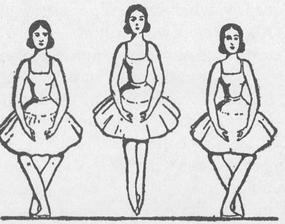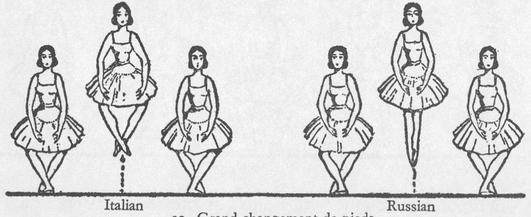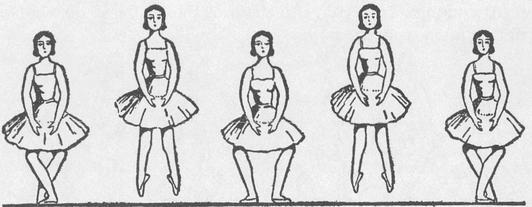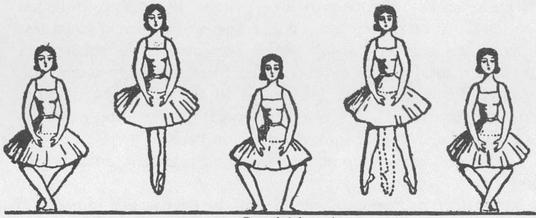Basic Principles of Classical Ballet (14 page)
Read Basic Principles of Classical Ballet Online
Authors: Agrippina Vaganova


48. Temps levé on two feet
The same thing is done from the 2nd and 5th positions. These jumps are called temps levé. Subsequently, during the study of temps levé in the middle of the floor, it is often done on one foot, i.e. one foot does the jump, the other keeps the position taken before the jump. After this we turn to changement de pieds.
CHANGEMENT DE PIEDS
PETIT CHANGEMENT DE PIEDS
Stand in 5th position, right foot front, demi-plié, push off from the floor, jump up, extending the toes and arching the feet. Coming down, change the feet, left foot will then be front. Come down as in temps levé: first the toes then heels, finishing the movement in demi-plié in 5th position.

49. Petit changement de pieds
This method develops softness and elasticity of the jump, ridding it of its hardness.
For more advanced pupils I prefer a different variation of petit changement de pieds. Everything is done as before, but the jump does not tear the feet away from the floor. The toes are touching the floor all the time, as if you were only rising on your toes. The movement is done in an uninterrupted series, without any pause on the plié, although it must be said that the accent is made not into the air, but into the floor, on the plié.
In this manner the exercise is still more energetic and effective in its results.
It is used at the conclusion of exercises in the centre (after allegro) in a fast tempo.
GRAND CHANGEMENT DE PIEDS
For this exercise demi-plié is done deeper and with greater effort in order to rise higher. Push off forcefully from the floor with the heels, bring the legs together and hold them this way until the very last moment and only then change them. Lower yourself in the same way as in petit changement de pieds.
The bigger the jump, the deeper should be the demi-plié before it. Attention must be paid that the heel, due to the strain, should not be lifted from the floor.

50. Grand changement de pieds
When changing the legs in the air do not move them far apart. If you do that, you will lose the form of changement de pieds, because this step is a change of feet in the 5th position. The legs should be moved apart only as much as is needed for the transfer, no more.
At the beginning of the study of jumps, attention must be paid to the arms, which must remain absolutely relaxed from the shoulders to the hands, slightly curved, as in the preparatory position; they must not jerk as if trying to help the movement of the legs.
In the Italian school it is customary to bend the knees when doing changement de pieds.
PAS ÉCHAPPÉ
PETIT ÉCHAPPÉ
Demi-plié in 5th position, push off with the heels, and immediately, with extended toes and straightened knees, jump into 2nd position in demi-plié, adhering strictly to the directions given for plié in 2nd position. Return with the same kind of a jump, with extended toes and straightened knees, finishing in 5th position.
This pas can also be done in 4th position croisé and effacé, giving the arms an appropriate pose. In general, however, during small jumps the poses of the arms should not be high. The high positions of the arms should be left for big jumps.
In doing échappé one must watch that the plié on both feet is even; special attention to this must be paid when doing échappé in 4th position.

51. Petit échappé
Échappé can be done with a finish on one foot. The entire pas is the same as above, only the finish is different. The feet do not return into 5th position, but one of them goes sur le cou-de-pied front or back. This échappé is done in 4th position as well as 2nd.
GRAND ÉCHAPPÉ
In petit échappé, in the jump, the legs open immediately in 2nd position. In grand échappé extend the legs, after a deep demi-plié, in a closed 5th position during the highest possible jump, and only coming down, open them into 2nd position. Return to 5th position also from a high jump, forcefully pushing off from the floor with the heels.

52. Grand échappé
This échappé can also be finished on one foot, coming down into an attitude, arabesque, or développé forward at 90°, i.e. generally into a big pose.
PAS ASSEMBLÉ
Assemblé is the basis for the development of the jump in general. For beginners it is the solid foundation of the dance and the first step toward it.
In spite of the fact that assemblé is fairly complicated, it is one of the first steps to be taught to beginners. It is brought into classroom exercises early, because if the pupils understand assemblé further study will be easier for them.

53. Assemblé
Stand in 5th position, right foot front; demi-plié, with a sliding movement draw left leg to the side, and with the toe of the extended foot reach 2nd position on the floor; with right foot, which has remained in plié, push off the floor, extending the toes; then, both feet simultaneously, return to 5th position in demi-plié left foot front. From this plié the movement is repeated with the other leg, thus the execution of this pas constitutes a small progression forward.
One must pay attention to the exactness of 2nd position, i.e. not let the foot deviate into écarté forward or back; exactness during the elementary study of this step insures the subsequent correct execution of its more complex form, the large assemblé.
Assemble is also done backwards in the following manner: from 5th position, the front foot is drawn out into 2nd position, and at the finish placed into 5th position back.
In this manner (in two counts) assemblé is taught at the beginning.
In the next, more complicated form, the leg passes 2nd position at the height of 43° with a passing movement, without an accent in the 2nd position. This assemblé is done in one count. After this form we turn to the large assemble.
In the large assemblé, done backwards, right leg is thrust out to 90°, as in grand battement; the subsequent jump—a big one—carries the dancer to the side. At this moment the left leg must be in front of the right one and the legs held closed in the air, then the dancer lowers himself, on both legs simultaneously, into 5th position in demi-plié.
In order to create an impression of a higher jump, the Italians bend their knees after grand battement, before lowering themselves into 5th position. This bending of the knees during the jump renders the dance a grotesque character, spoiling its classic line.

54. Assemblé (Italian)
The large assemblé is usually done during the most winning moment of the execution of a dance. In order to have enough force for such a large movement, it is most effective to do just before it an auxiliary movement either in the form of a glissade or in the form of the following preparation: do a grand développé forward, fall on that foot in plié and push off forcefully, thrusting the other leg into 2nd position at 90°; the push-off then is more energetic and the entire movement gains in its effect.
In general, to make a jump stand out and to heighten its effect, it should be preceded and followed, not by a movement of equal size and strength, but by a smaller movement. One of the movements gains in its effect from the other.